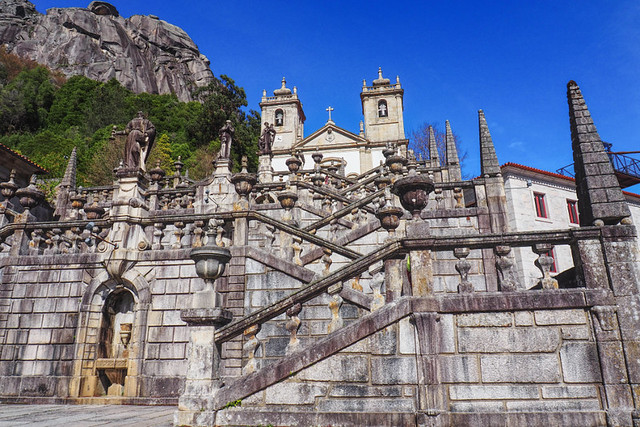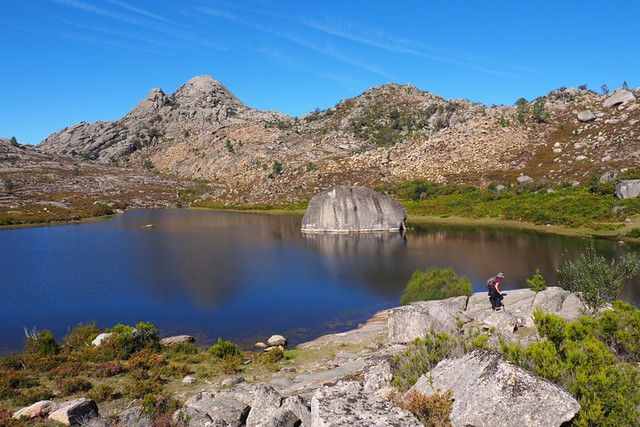Anyone who knows Portugal’s only National Park will be aware there is more than one mountain lake in Peneda-Gerês, but the one above Peneda itself will always be THE mountain lake to me.
The first time we walked to it, we started at the village of Peneda, nestled in the depths of a ravine close to the border with Spain. It was a sunny afternoon in February and the receptionist in the village’s small hotel suggested we tackle the short route, under 1.5km, to see the lake. It sounded like a pleasant stroll, but it turned out to be 1.5km straight up a mountain. Well, not quite straight up as the old, cobbled trading path zigged and zagged its way up the side of a ravine which rose like a wall above the Santuario de Nossa Senhora da Peneda, an eye-catching piece of religious architecture which resembles a mini version of Braga’s Bom Jesus do Monte.
The small lake, an intense blue oasis in a sea of gigantic grey boulders and ruddy brown bracken, was a surprising jewel in the rugged landscape. Of course, we knew it was there, it was the reason for torturing our thigh muscles after all, but the sight of the splash of blue crowning the mountain still came as a surprise. We plonked ourselves down at the water’s edge and replenished expended energy with the hikers’ staple, a cheese and ham baguette, while a long-horned Cachena cow lapped languidly at the water a few yards away.
It felt like stumbling across a secret.
Stumbling across ‘secrets’ is a travel writing cliché, designed to make a visit to relatively well-known places sound more like a discovery. And yet, on some occasions it can feel as if that is exactly what it is. Peneda-Gerês is not an area that is particularly well known outside of Portugal. Not only that, walking it without a guide or directions isn’t easy, which keeps the number of visitors low. The path from Peneda is straightforward-ish but tackling the route from other directions isn’t.
An alternative route to the mountain lake in Peneda-Gerês
The second time we walked to the mountain lake we started at Rouças, a village at the mouth of a ravine to the west of Peneda. The first section was easy to follow. However, at Gaveira markings went AWOL, and the assistance of a local woman with a mountain of straw balanced on her back was required. Even she wasn’t too sure about the correct onward route. Now that a proper road connects Gaveira with Peneda, there’s no need for villagers to hoof it across the mountains.
From Gaveira, the path took us through forest glades and across granite slabs over gurgling brooks, climbing out of pastoral lands where granite villages tumbled down the hillside to meet emerald terraces carved into the slopes. It felt like a part of Portugal which was frozen in time, a feeling aided and abetted by the encounter with the woman carrying bedding for cattle.
As we ascended, a more gradual incline than from Peneda but still decent enough, pines and greenery became scarcer, replaced by ferns and hardy shrubs until we traversed the massif’s bald head, a smooth-ish curve mainly made up of huge boulders. Panoramic views across Peneda-Gerês unravelled with every step. It is on this stretch especially that finding waymarks can be difficult. Spotting the evidence of others who have passed this way isn’t so easy when the ground is made from granite rock. It’s at these times a map and compass prove their worth.
And then the pântano appeared, the small artificial lake as deep blue and welcoming as the last time we visited it. It is a gloriously wild part of Portugal, a rugged land roamed by Cachena cattle, wild Garrano horses, and a few Iberian wolves.
Approaching the route from the west rewards doubly. First, the descent into Peneda isn’t as taxing as the ascent out of Peneda, and looking down on the village squeezed into the ravine below is a spectacular climax. The second is the overwhelming sense of achievement at crossing the mountains to arrive virtually at the door of the Santuario de Nossa Senhora da Peneda.
It was more than reaching the end of a walking route, it felt like we’d completed a pilgrimage.






Be the first to comment